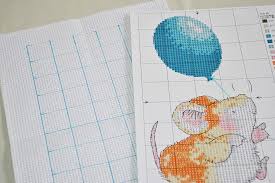Sometimes it’s hard to find just the right cross stitch pattern. That’s why many stitchers are learning to design their own charts.
Many cross stitchers addicted to stitching can become just as obsessed with creating their patterns. With practice, you can create unique tables that not only you enjoy stitching yourself, but can also partake with other stitchers.
Design the Patterns on Graph Paper
If you want to design a simple graph, you can do it manually using graph paper and colored pencils. First, look for source photos for your pattern. Keep a working file of any pictures that could be used for design. For example, save postcards, greeting cards, etc.
Sketch your design: After sketching out your design on plain paper, trace it onto tracing paper. Then, using carbon transfer paper, transfer it to graph paper.
- Graph paper – Compare the size of your graph paper to your Aida stitching cloth. For example, if your graph paper has 10 square per inch and your material is 14 count, realize the finished needlework will be somewhat modest than your drawing. If you want your graph paper to match your fabric, check with your neighborhood needlework shop to see if they trade cross stitch graph paper or purchase it online.
- Block in your design – On another graph paper block in your stitches with the appropriate colors (using colored pencils). For full stitches, block in the entire square, while half stitches are half-squares (triangles, facing the direction of the intended half-stitch.)
Cross Stitch Software
For more complicated patterns, use cross stitch programs. For more than the past decade stitchers have been receiving help designing charts using cross stitch software programs. By only drawing a design on a computer screen (using your mouse, of course) you can make a creative pattern as if you were using graph paper. Most programs offer a wide range of colors in at least two-three different embroidery floss brands (such as DMC, JP Coats, and Anchor.)
Photo-to-Chart
Don’t worry if you lack artistic skills because cross stitch software includes photo-to-chart characteristics where you can imply any picture into a pattern in minutes. What’s more, you can compare the size of the pattern, as well as exclude the irrelevant background. To get a quality design, you need to implement various uses to refine it. In other words, you don’t just imply a photo and presto; you have a picture ready to stitch.
Tips for Converting Photos into Charts
Select quality photos – Select only high-quality photos that do not have shadows. It’s also best to select photos with little or not background if you’re creating a portrait of a person. It’s not so much the size of the photo, but how clear and converged it is, as pictures as small as 3” x 4” has produced high-quality designs.
- Reduce the number of colors – Before even implying your design, limit the number of colors.
- Fine tune – As the computer picks up stray shades, you need to “edit” the design, excluding stray colors, etc.
- Omit background – Except if you want to stitch a lot of backgrounds, you’re better off dropping a lot of the background.
Remove any unneeded colors and those with small numbers. Most programs have a “floss usage” tab wherever you can see how many stitches for each color. For instance, if a color uses as few as one to ten colors, you probably need to remove it unless it’s required. Just make sure to restore the vacant squares.
Once you’ve designed your first cross stitch pattern, you’ll want to create more. It can become as addictive as stitching.

